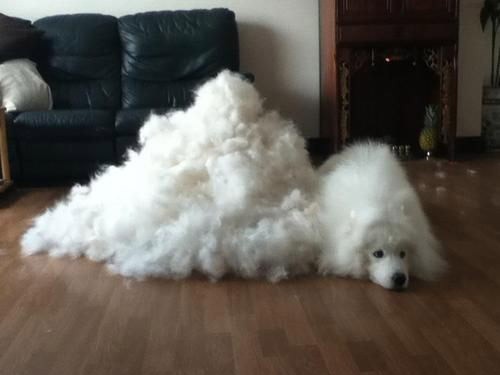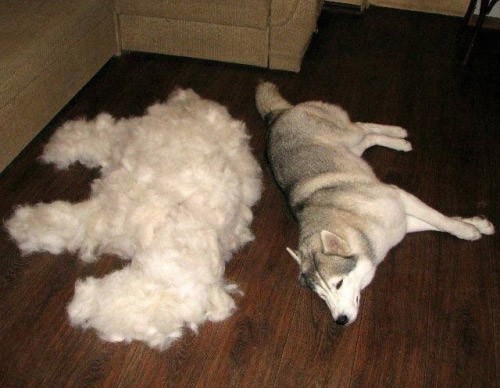Shedding: A Hairy Problem for Dog Owners
Posted by Jenn on 03/08/2016
Whether you’re just contemplating your first canine addition to your family or you’ve already got one (or two, or five) in the house, you’ve probably accepted that dog hair will be part of your life. After all, the only surefire way to make sure your home is free of pet hair is not to have any pets, and where’s the fun in that? But that doesn’t mean you want everyone who enters your home to leave a little bit furrier. Luckily, there are some things you can do to keep dog hair from becoming a decorating motif in your home.
 Source: Pinterest
Source: Pinterest
Shedding and Allergies
When it comes to pet allergies, it’s usually the dander, not the hair itself that causes the reaction. Both short-haired and long-haired dogs can be heavy or light shedders, depending on whether they have an undercoat or not. Therefore, allergy sufferers should focus on breeds that are low-shedding rather than short-haired. Having said that, fluffy dogs may be a poor match for people with seasonal allergies, because the dogs’ coats tend to trek in more pollen and other outdoor allergens.
Breed Differences
There is no such thing as a truly non-shedding dog, but some breeds seem to create dust bunnies the size of horses. It’s no surprise that the biggest, fluffiest dogs you can think of—Newfoundlands, St. Bernards, Great Pyrenees, etc.—are all champion shedders. Many herding dogs, like collies, sheepdogs, and German shepherd dogs, and sporting dogs, such as Labradors and golden retrievers, also have double coats and shed quite a bit. And if your dog was originally bred to live outdoors in very cold climates—think huskies, chow chows, and Samoyeds—you can bet he will shed like crazy, especially in the spring.
 Source: Blue Bonnet Grooming
Source: Blue Bonnet Grooming
On the other end of the spectrum, there are dogs with very short single coats, including basenjis and greyhounds, which hardly shed at all. Other low-shedding dogs include dachshunds, Yorkies, Schnauzers, poodles (and often Labradoodles and goldendoodles, depending on the mix), redbone coonhounds, Chihuahuas, Portugese water dogs, bichon frises, and most terriers. Low shedding doesn’t necessarily mean low maintenance, though—some of these breeds, such as poodles, need regular trims to keep their hair from becoming unruly.
Reducing Dog Hair Around the House
The first line of defense is a good brushing. Choose a brush based on the type of coat your dog has. (Actually, you might find you need more than one type of brush to get all the dead hair.) For example, you might get a slicker brush, a bristle brush, or a pin brush. Any of these will catch the loose hair and to make your dog’s coat softer and cleaner. Get your puppy accustomed to being brushed right away, so it becomes a fun bonding exercise and not a reason for your dog to panic.
Freshly shed hair is easier to remove than hair that has settled into carpeting or upholstery, so vacuum frequently. For smaller jobs, a lint roller may work well. If your dog is allowed on the furniture, you may want to invest in washable slipcovers or blankets. Some families even take their dogs’ hair color into account when choosing new flooring or furniture. A crisp white couch would not be the best choice with a Newfoundland in the house!
 Source: Top Dog Country Club
Source: Top Dog Country Club
